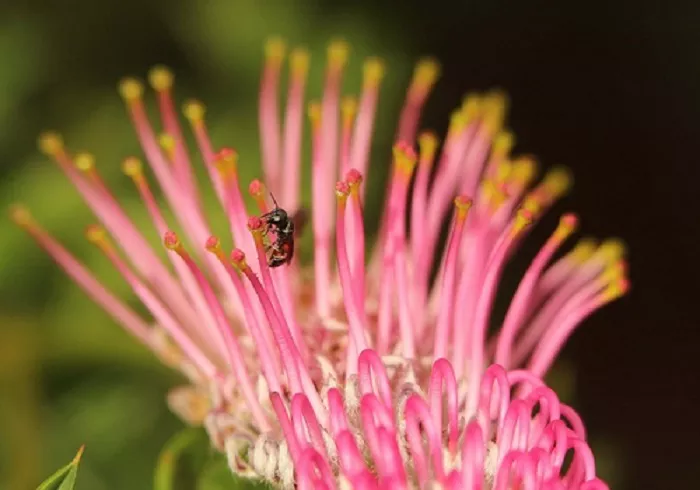In the sun-drenched landscapes of Australia, where nature’s tapestry is woven with vibrant hues and fragrant scents, bees play a crucial role in the delicate balance of ecosystems. These industrious pollinators are not just vital for honey production but also for the health and diversity of our gardens and wildlands. Understanding which flowers attract bees can transform your garden into a buzzing haven of life. This article explores the floral favourites of bees across Australia, offering insights into how you can create a bee-friendly oasis in your own backyard.
The Allure of Native Blooms
Australia’s native flora is a treasure trove for bees. Many indigenous flowers have evolved alongside these pollinators, developing unique features that make them irresistible. Eucalyptus trees, with their prolific blossoms, are a prime example. Their nectar-rich flowers bloom in clusters, providing an abundant food source throughout the year. The iconic Banksia genus also stands out. These plants produce large, striking inflorescences that are rich in nectar and pollen. Bees are particularly drawn to the vibrant yellow and orange hues of Banksia integrifolia and Banksia serrata, which stand out against the green foliage.
The Role of Colour in Bee Attraction
Bees have a remarkable ability to perceive colour, and they are particularly attracted to shades of blue, purple, and yellow. In Australia, Lavender (Lavandula) is a bee magnet. Its fragrant purple flowers bloom in summer, releasing a sweet aroma that draws bees from afar. The Sunflower (Helianthus annuus), with its bright yellow petals and dark centres, is another favourite. These flowers are not only visually appealing but also produce copious amounts of nectar and pollen. Planting a mix of these colours can create a visually stunning and bee-friendly garden.
The Scent Factor
Scent plays a significant role in attracting bees. Flowers with strong, sweet fragrances are particularly appealing. Citrus trees, such as Lemon (Citrus limon) and Orange (Citrus sinensis), produce blossoms with a delightful citrus scent. Bees are drawn to these flowers not only for their fragrance but also for the high-quality nectar they provide. The Grevillea genus, with its diverse range of species, also offers a variety of scents. Grevillea robusta, commonly known as the Silky Oak, has distinctive yellow and red flowers that emit a subtle, sweet aroma, attracting bees and other pollinators.
Seasonal Blooms for Year-Round Appeal
Creating a bee-friendly garden involves selecting flowers that bloom at different times of the year. In spring, Wisteria (Wisteria sinensis) is a stunning addition. Its cascading clusters of purple flowers are rich in nectar and pollen, attracting bees early in the season. Boronia (Boronia megastigma) is another spring bloomer with small, fragrant pink flowers that bees adore. As summer arrives, Salvia (Salvia spp.) takes centre stage. These plants produce tall spikes of flowers in various colours, providing a continuous supply of nectar throughout the season.
In autumn, Aster (Aster spp.) blooms, offering a late-season food source for bees. These daisy-like flowers come in shades of blue, purple, and white, adding a splash of colour to the garden while supporting pollinators.
Perennials: The Backbone of a Bee Garden
Perennial flowers are essential for a sustainable bee-friendly garden. They return year after year, providing a reliable food source. Agastache (Agastache spp.), also known as Hyssop, is a hardy perennial that produces spikes of tubular flowers in shades of blue, pink, and white. Bees are attracted to its nectar-rich blooms, which are also drought-tolerant, making them ideal for Australian gardens. Verbena (Verbena bonariensis) is another excellent choice. Its tall, airy stems are covered in clusters of small purple flowers that bees find irresistible. These perennials not only support bees but also add structure and beauty to the garden.
Annuals for Instant Impact
Annuals can provide a quick burst of colour and nectar. Zinnia (Zinnia elegans) is a popular choice, with its large, brightly coloured flowers that bloom from summer to autumn. Bees are drawn to the variety of colours, from pink and purple to orange and red. Marigold (Tagetes spp.) is another annual that bees find appealing. Its bright yellow and orange flowers are rich in pollen and nectar, making them a valuable addition to any bee garden. Planting a mix of annuals can create a vibrant and diverse environment for bees.
Creating a Bee-Friendly Environment
Attracting bees to your garden is not just about the flowers. Providing a suitable habitat is equally important. Bees need shelter, water, and a pesticide-free environment. Creating a bee hotel using bamboo canes or hollow stems can provide nesting sites for solitary bees. A shallow dish filled with water and floating stones can offer a drinking spot. Avoiding chemical pesticides and opting for organic gardening practices can help create a safe and healthy environment for bees.
The Importance of Diversity
A diverse garden is a bee-friendly garden. Planting a variety of flowers with different shapes, sizes, and blooming times ensures that bees have a continuous supply of food. Combining native plants with introduced species can create a rich tapestry of floral resources. For example, pairing Banksia with Lavender or Eucalyptus with Salvia can provide a range of nectar and pollen sources throughout the year.
Engaging with the Community
Creating a bee-friendly garden is not just a personal endeavour. It can also be a community effort. Participating in local gardening clubs or beekeeping associations can provide valuable insights and support. Sharing knowledge and resources can help spread the importance of pollinators and encourage others to create bee-friendly spaces.
Conclusion
In Australia’s diverse landscapes, bees play a vital role in maintaining the health of our ecosystems. By understanding which flowers attract bees and creating a bee-friendly garden, we can support these essential pollinators. From native blooms to seasonal flowers, and from perennials to annuals, there are countless options to create a vibrant and sustainable garden. By providing a diverse range of flowers, a suitable habitat, and engaging with the community, we can ensure that bees continue to thrive in our gardens and wildlands.


